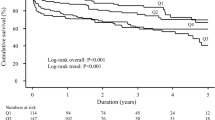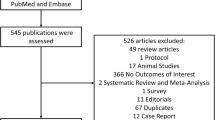Abstract
Heart failure is characterized by activation of the immune system which is strongly associated with disease severity and outcome. We sought to compare the prognostic impact of two established inflammatory markers — interleukin-6 (IL-6) and high-sensitivity C-reactive protein (hsCRP) — in patients with chronic heart failure. In stable, optimally managed outpatients with chronic heart failure, baseline levels of hsCRP and IL-6 were determined. Clinical follow-up was obtained and the rate of events (heart failure related deaths or hospitalizations) were recorded. We included 201 patients (32.7% female, NYHA class II [66.2%] or III [33.8%], mean age 70 years). During a median follow up of 614 (367−761) days, 64 (30.9%) patients experienced an event; those with an event had higher levels of hsCRP (median 2.93 [interquartile range 2.36−8.92] vs 2.23 [1.32−5.77] mmol/l) and IL-6 (7.8 [4.7−10.3] vs 4.3 [2.6−7.9] pg/ml). However, on Cox multivariate analysis, IL-6 but not hsCRP emerged as an independent predictor of prognosis (hazard ratio HRadjusted 2.74, 95% confidence interval 1.17−6.43; P = 0.020). Our findings suggest that IL-6 is a better prognostic predictor than hsCRP in patients with chronic stable heart failure.
Similar content being viewed by others
References
Butler J, Khadim G, Paul KM, Davis SF, Kronenberg MW, Chomsky DB, Pierson RN, Wilson JR (2004) Selection of patients for heart transplantation in the current era of heart failure therapy. J Am Coll Cardiol 43:787–793
Zugck C, Haunstetter A, Krüger C, Kell R, Schellberg D, Kübler W, Haass M (2002) Impact of beta-blocker treatment on the prognostic value of currently used risk predictors in congestive heart failure. J Am Coll Cardiol 39:1615–1622
Mann D, Young J (1994) Basic mechanism in congestive heart failure: recognizing the role of proinflammatory cytokines. Chest 105:897–904
Anker S, Von Haehling S (2004) Inflammatory mediators in chronic heart failure: an overview. Heart 90:464–470
Sharma R, Rauchhaus M, Ponikowski PP, Varney S, Poole-Wilson, PA, Mann DL, Coats AJS, Anker SD (2000) The relationship of the erythrocyte sedimentation rate to inflammatory cytokines and survival in patients with chronic heart failure treated wit angiotensin-converting enzyme inhibitors. J Am Coll Cardiol 36:523–528
Deswal A, Petersen NJ, Feldman AM, Young JB, White BG, Mann DL (2001) Cytokines and cytokine receptors in advanced heart failure: an analysis of the cytokine database from the Vesnarinone trial (VEST). Circulation 103:2055–2059.
Papanicolaou D, Wilder R, Monolagas S, Chrosos GP (1998) The pathophysiologic roles of interleukin-6 in human disease. Ann Intern Med 128:127–137
Kanada T, Takahashi T (2004) Interleukin-6 and cardiovascular disease. Jpn Heart J 45:183–193
Kell R, Haunstetter A, Dengler T, Zugck C, Kubler W, Haass M (2002) Do cytokines enable risk stratification to be improved in NYHA functional class III patients? Comparison with other potential predictors of prognosis. Eur Heart J 23:70–78
Shah SJ, Marcus GM, Gerber IL, McKeown BH, Vessey JC, Jordan MV, Huddleston M, Foster E, Chatterjee K, Michaels AD (2006) High-sensitivity C-reactive protein and parameters of left ventricular dysfunction. J Card Fail 12:61–65
Lamblin N, Mouquet F, Hennache B, Dagorn J, Susen S, Bauters C, de Groote P (2005) High-sensitive C-reactive protein: potential adjunct for risk stratification in patients with stable congestive heart failure. Eur Heart J 26:2245–2250
Kistorp C, Raymond I, Pedersen F, Gustafsson F, Faber J, Hildebrandt P (2005) N-terminal pro-brain natriuretic peptide, Creactive protein, and urinary albumin levels as predictors of mortality and cardiovascular events in older adults. JAMA 293: 1609–1616
Maeda K, Tsutamoto T, Wada A, Mabuchi N, Hayashi M, Tsutsui T, Ohnishi M, Sawaki M, Fujii M, Matsumoto T, Kinoshita M (2000) High levels of plasma brain natriuretic peptide and interleukin-6 after optimized treatment for heart failure are independent risk factors for morbidity and mortality in patients with congestive heart failure. J Am Coll Cardiol 36:1587–1593
Tsutamoto T, Hisanaga T, Wada A, Maeda K, Ohnishi M, Fukai D, Mabuchi N, Sawaki M, Kinoshita M (1998) Interleukin-6 spillover in the peripheral circulation increase with the severity of heart failure and high plasma level of interleukin-6 is an important prognostic predictor in patients with congestive heart failure. J Am Coll Cardiol 31:391–398
Anand IS, Latini R, Florea VG, Kuskowski MA, Rector T, Masson S, Signorini S, Mocarelli P, Hester A, Glazer R, Cohn JN, for the Val-HeFT Investigators (2005) C-reactive protein in heart failure: Prognostic value and the effect of valsartan. Circulation 112:1428–1434
Dupont W, Plummer W (1990) Power and sample size calculations: a review and computer program. Controlled Clin Trials 11:116–128
Ueno A, Murasaki K, Hagiwara N, Kasanuki H (2007) Increases in circulating T lymphocytes expressing HLA-DR and CD40 ligand in patients with dilated cardiomyopathy. Heart Vessels 22:316–321
Fukunaga T, Soejima H, Irie A, Sugamura K, Oe Y, Tanaka T, Kojima S, Sakamoto T, Yoshimura M, Nishimura Y, Ogawa H (2007) Expression of interferon-gamma and interleukin-4 production in CD4(+) T cells in patients with chronic heart failure. Heart Vessels 22:178–183
Burger A, Benicke M, Deten A, Zimmer H-G (2001) Catecholamines stimulate interleukin-6 synthesis in rat cardiac fibroblasts. J Am Physiol Heart Circ Physiol 201:H14–H21
Lee DL, Sturgis LC, Labazi H, Osborne JB, Fleming C, Pollock JS, Manhiani M, Imig JD, Brands MW (2005) Angiotensin II hypertension is attenuated in interleukin-6 knockout mice. Am J Physiol Heart Circ Physiol 290:H935–H940
Arstall MA, Sawyer DB, Fukuzawa R, Kell R (1999) Cytokinemediated apoptosis in cardiac myocytes: the role of inducible nitric oxide synthase induction and peroxisome generation. Circ Res 85:829–840
Blum A, Miller H (2001) Pathophysiological role of cytokines in congestive heart failure. Ann Rev Med 52:15–27
Franchimont N, Rydziel S, Delany A, Canalis E (1997) Interleukin-6 and its soluble receptor cause a marked induction of collagenase 3 expression in rat osteoblast cultures. J Biol Chem 272:12144–12150
Janssen SP, Gayan-Ramirez G, Van Den Bergh A, Herijgers P, Maes K, Verbeken E, Decramer M (2005) Interleukin-6 causes myocardial failure and skeletal muscle atrophy in rats. Circulation 111:996–1005
Hirota H, Yoshida K, Kaishimoto T, Taga T (1995) Continuous activation of gp139, a signal transducing receptor component for interleukin-6-related cytokines, causes myocardial hypertrophy. Proc Natl Acad Sci USA 92:4862–4866
Varol E, Ozaydin M, Altinbas A, Aslan SM, Dogan A, Dede O (2007) Elevated carbohydrate antigen 125 levels in hypertrophic cardiomyopathy patients with heart failure. Heart Vessels 22: 30–33
Ferrari R, Bachetti T, Confortini R (1995) Tumor necrosis factor soluble receptors in patients with various degrees of congestive heart failure. Circulation 92:1479–1486
Torre-Amione G, Kapadia S, Benedict C, Oral H, Young J, Mann DL (1996) Proinflammatory cytokine levels in patients with depressed left ventricular ejection fraction: a report from the Studies of Left Ventricular Dysfunction (SOLVD). J Am Coll Cardiol 31:391–398
Yin WH, Chen JW, Jen HL, Chiang MG, Huang WP, Feng AN, Shing Young M, Lin SJ (2004) Independent prognostic value of elevated high-sensitive C-reactive protein in chronic heart failure. Am Heart J 146:931–938
Bozkurt B (2000) Activation of cytokines as a mechanism of disease progression in heart failure. Ann Rheum Dis 59:90–93
Munger M, Johnson B, Amber I, Callahan K, Gilbert E (1996) Circulating concentrations of proinflammatory cytokines in mild or moderate heart failure secondary to ischemic or idiopathic dilated cardiomyopathy. Am J Cardiol 77:723–727
Tsutamoto T, Asai S, Tanaka T, Sakai H, Nishiyama K, Fujii M, Yamamoto T, Ohnishi M, Wada A, Saito Y, Horie M (2007) Plasma level of cardiotrophin-1 as a prognostic predictor in patients with chronic heart failure. Eur J Heart Fail 9:1032–1037
Rauchhaus M, Doehner W, Francis D (2000) Plasma cytokine parameters and mortality in patients with chronic heart failure. Circulation 102:3060–3067
Ferrari R (2002) Interleukin-6: a neurohumoral predictor of prognosis in patients with heart failure: light and shadow (editorial). Eur Heart J 23:9–10
Gonway D, Buggins P, Hughes E, Lip GYH (2004) Relationship of interleukin-6 and C-reactive protein to the prothrombotic state in atrial fibrillation. J Am Coll Cardiol 43:2075–2082.
Kjekshus J, Apetrei E, Barrios V, Böhm M, Cleland JG, Cornel JH, Dunselman P, Fonseca C, Goudev A, Grande P, Gullestad L, Hjalmarson A, Hradec J, Jánosi A, Kamenský G, Komajda M, Korewicki J, Kuusi T, Mach F, Mareev V, McMurray JJ, Ranjith N, Schaufelberger M, Vanhaecke J, van Veldhuisen DJ, Waagstein F, Wedel H, Wikstrand J, for the CORONA Group (2007) Rosuvastatin in older patients with heart failure. N Engl J Med 357: 2248–2261
Author information
Authors and Affiliations
Corresponding author
Rights and permissions
About this article
Cite this article
Jug, B., Salobir, B.G., Vene, N. et al. Interleukin-6 is a stronger prognostic predictor than high-sensitive C-reactive protein in patients with chronic stable heart failure. Heart Vessels 24, 271–276 (2009). https://doi.org/10.1007/s00380-008-1111-4
Received:
Accepted:
Published:
Issue Date:
DOI: https://doi.org/10.1007/s00380-008-1111-4




